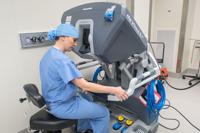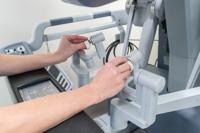[ad_1]
MANKATO — As an active runner, John Tanke wanted a speedy recovery following his hernia surgery last August.
“Any runner is going to be concerned about losing fitness and starting back at square one,” he said.
So when his doctor laid out the benefits of robot-assisted surgery, especially the quicker recovery times, it allayed any initial hesitation about the method.
Mayo Clinic Health System in Mankato had recently expanded its robotic options to general surgical procedures. Tanke, 47, was one of the first patients to undergo robotic surgery for a hernia locally. He said he was back to work at Taylor Corp. two days later, needed minimal pain medication and ran again within three weeks.

Dr. Tara Krosch, a general surgeon at Mayo Clinic Health System in Mankato, demonstrates how she positions herself on the console controlling robotic surgical equipment. Fingertip controls and foot pedals maneuver the robot, allowing for cutting, retracting and cauterizing tissue during procedures. Photo by Jackson Forderer
Dr. Tara Krosch, one of two Mayo in Mankato surgeons now offering the surgical option, said robot-assisted procedures grew increasingly common over the past five years for minimally invasive surgeries. Mankato’s was the first hospital within the Mayo Clinic Health System network to roll out robotics for general surgery.
“We saw this as an opportunity for general surgery here to really start using this technology and starting to give patients the option of having a robotic or more minimally invasive repair here in Mankato,” Krosch said.
The da Vinci robotic surgical system was a fixture at Rochester’s Mayo Clinic after the Food and Drug Administration’s approval of the technology in 2000. Mayo in Mankato’s foundation funded the equipment in 2011, and it’s since been used mainly for urological or gynecological procedures like prostatectomies and hysterectomies.
The move into general surgery, where the robot assists during ventral and inguinal hernia procedures, came last summer. Krosch said it provides another option for patients in need of minimally invasive repairs.
“If you can have an operation with tiny incisions and get back to normal healing in a rapid fashion, that’s what we all want,” she said.
Both laparoscopic and robotic surgeries involve the small incisions through which the medical team inserts tubes with cameras and surgical instruments. The difference is in how the instruments are used, with the surgeon manually holding the equipment during a laparoscopic procedure rather than controlling the robot’s movement.
Krosch or fellow surgeon Megan Gilmore performs the robotic operations from a console feet away from the patient. Fingertip controls and foot pedals control four arms used to retract, cauterize, cut or staple tissue. Another medical professional overlooks the patient during the process.

Robotic surgery is used for minimally invasive procedures like hernia surgeries. Dr. Tara Krosch said the technology has a learning curve but is becoming increasingly common. Photo by Jackson Forderer
There is a learning curve to operating the robot, but Krosch said she prefers the technology because it improves maneuverability and precision.
“I’ve done a ventral hernia and inguinal hernia so many times in my career that to be using a robot is just using a different piece of technology to complete the operation,” she said.
Not all patients are eligible for the robotic or laparoscopic procedures. A large hernia could require open surgery, resulting in lengthier hospital stays, recoveries and more narcotics for pain management.
Tanke expected a lengthier recovery after seeing his dad go through a hernia repair about 30 years ago. He described the elder Tanke as a tough farmer, this larger-than-life figure who during the recovery struggled to get up and down the stairs.
“My memory of that is it’s the first time I ever saw him in so much pain,” he said.
The quicker recovery not only allowed Tanke to lace up his running shoes earlier than expected, it ensured a garage project went ahead as planned. He said the garage needed to be ready for his daughter’s upcoming graduation party.
“I was helping lift sheets for Sheetrock six weeks post surgery,” he said. “I couldn’t have been happier with how that went.”
A third surgeon at Mayo in Mankato could finish training for robotic procedures by the end of the year. Krosch said Mayo has a goal to update Mankato’s robotic technology and open up more surgical options in the coming years.
[ad_2]
Source link





Leave A Comment
You must be logged in to post a comment.